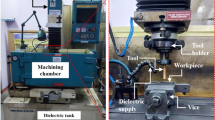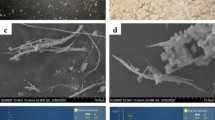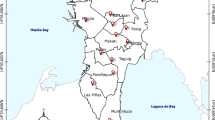Abstract
In this study aimed to evaluate the pollution extent of metals and nonmetals inside and outside the ferrosilicon production factory in Edfu, Aswan, Egypt, raw materials (quartz, cokes, iron oxides), ferrosilicon alloy, silica fume, dust and suspended dust (at different sites) samples were collected from the factory, and fallen dust samples were collected from outside the factory, horizontally (at different sites and different distance and directions) and vertically (at different floors in the selected buildings). Gravimetric methods, X-ray fluorescence (XRF), flame photometer, wide range carbon determinator and atomic absorption spectroscopy tools were used for elements determination. The results indicating that the fallen dust and its element contents on southern factory walls being higher than those on eastern factory walls may be due to the nature of the dusts and effects of wind force and wind direction. Fallen dust levels in different regions outside the factor were found to be affected by the distance, direction and floors. The nature of dust samples was affected by gravity and the suspended dust in different factory units depended on the work capacity and method of handling materials by personnel in different production units. Silica fume was a complicated problem, had dangerous effect against the workers' health, and was characterized by high concentrations of SiO2 (90.6%∼93.6%) and heavy metals (Mn, 420.6×10−6; Fe, 2354×10−6∼2685×10−6; Co 80.7×10−6∼101.6×10−6 and Ni, 5.3×10−6∼6.05×10−6). The TSP (Total Suspended Particulate) levels in all factory units were higher than the recommended air quality value (70 μg/m3) under Egyptian law. The effect of ferrosilicon factory fallen dust on the surrounding regions decreased with increasing distance between the factory and these regions. The suspended dust samples in the factory units and their components greatly exceeded national and international standards, so health and environmental criteria must be enforced on these units.
Similar content being viewed by others
References
ATSDR (Agency for Toxic Substance and Disease Registry), 1992. Impact of Lead-contaminated Soil on Public Health Atlanta, Georgia, p. 30333.
Bertine, K.K., Goldberg, E.D., 1971. Fossil fuel combustion and the major sedimentary cycle.Science,173:233–235.
Bishop, L., Hill, W.J., 1983. A study of the relationship between blood lead levels and accupational air-lead levels.Amer. Stat.,37:471–475
Body, P., Inglis, G., Dolan, P., Mulcahy, D., 1991. Environmental lead: A review.Crit. Rev. Environ. Control,20:299–310.
Castranova, V., 1996. Silica and Silica Induced Lung Diseases. CRC Press, Boca Raton (FI).
Chung, D.D.L., 2002. Improving cement-based materials by using silica fume.Journal of Materials Science,37:673–682.
Drivdal, G.A., 1990. Specification of Ores and Alloys Kristiansand Silica Laboratory. Elkem Materials. NORWAY.
ECS (Egyptian Chemical Standards), 1994. Law No. 4, Protection of the Nile River and Water Stream from Pollution. Ministry of Irrigation, Cairo, Egypt.
Egyptian Environmental Affair Agency, 1996. Lead Smelting in Egypt-Baseline Study (Private Lead Smelters in Greater Cairo). Technical Cooperation Office for the Environment.
Falatah, A.M., 1974. Fractionation of micronutrient cations in a selected Saudi Arabia subjected to different tillage practices.Arid Soil Research and Rehabilitation,7:63.
Flanagan, F.J., 1973. Values for international geochemical reference samples.Geochim. Cosmochi. Acta,37:1189–1194.
Hauksdottir, A.S., Gestsson, A., Vesteinsson, A., 1998. Submerged are ferrosilicon furnance simulator: Validation for different furnaces and operating ranges.Control Engineering Practice,6:1035–1042.
Ibiebele, D.D., 1979. Air and blood levels in a battery factory.Sci. Tot. Enviro.,152(3):269–273.
Jabeen, N., Ahmed, S., Hassan, S.T., Alam, N.M., 2001. Levels and sources of heavy metals in house dust.J. Radio Analytical and Nuclear Chemistry,247(1):145–149.
JSA (Japanese Standards Association), 1990. Ferrous Materials and Metallurgy. TOKYO, JAPAN.
Linzon, S.N., Chai, B.L., Temple, P.J., Pearson, R.G., Smith, M.L., 1976. Lead contamination of urban soils and vegetation by emission from secondary lead industries.J. Air Pollute Contr. Assoc.,26:650–654.
Lumens, M.E., Spee, T., 2001. Determination of exposure to respirable quartz dust in the construction industry.Ann. Occup. Hyg.,45(7):585–595.
Modaihsh, A.S., 1997. Characteristics and composition of the fallen dust sediments on Riyadh city, Asudi.Journal of Arabia Arid Environments,36(2):211–223.
Norvell, W.A., Wu, J., Hopkins, D.G., Welch, R.M., 2000. Association of cadmium in Durum Wheat Grain with soil chloride and chelate-extractable soil cadmium.Soil Science Society of America Journal,64:2162–2168.
Nriagu, J.O., 1989. A global assessment of nature, sources of atmospheric trace metals,Nature,338:47–49.
Nriagu, J.O., Pacyna, J.M., 1988. Quantitative assessment of world wide contamination of air, water and soils by trace metals.Nature,333:134–139.
Popov, Y., 1989. Buligarium Specification of Ore and Alloys. SOFIA.
Sharaf, E.A., Garib, A.M., Khaled, N., 1999. Impact of high way maintenance decisions on air quality.Environmental Conference, Cairo,1:453–463.
Stern, A.C., Bouble, R.W., Turner, D.B., Fox, D.L., 1984. Fundamentals of Air Pollution. 2nd Ed., Academic Press, London.
Stwart, E.A., 1993. Chemical Analysis of Ecological Materials. 2nd Ed., Black Well Scientific Publications, Boston.
Susanna, T.T., Kin, C.L., 2000. Home sweet home. A case study of household dust contamination in Hong Kong.The Science of The Total Environment,256(2–3):115–123.
van Leeuwen, F.X.R., 1997. Update and revision of WHO air quality guidelines for Europe.environmental Research Forum,7–8:22–25.
Wong, S.C., Li, X.D., Zhang, G., Qi, S.H., Min, Y.S., 2002. Heavy metals in agricultural soils of the pearl river delta, south China.Environmental Pollution,119:33–44.
Xiandong, P., Chi, S., Chan, R.C., Barry, J., 1997. Concentration and Chemical Partitioning of Heavy Metals in Road Dust and Urban Soils in Hong Kong. 4th International Symposium on Environ. Geochem. Vail, USA.
Author information
Authors and Affiliations
Rights and permissions
About this article
Cite this article
Soltan, M.E., Rageh, H.M., Rageh, N.M. et al. Experimental approaches and analytical technique for determining heavy metals in fallen dust at ferrosilicon production factory in Edfu, Aswan, Egypt. J. Zheijang Univ.-Sci. B 6, 708–718 (2005). https://doi.org/10.1007/BF02842427
Received:
Accepted:
Issue Date:
DOI: https://doi.org/10.1007/BF02842427




